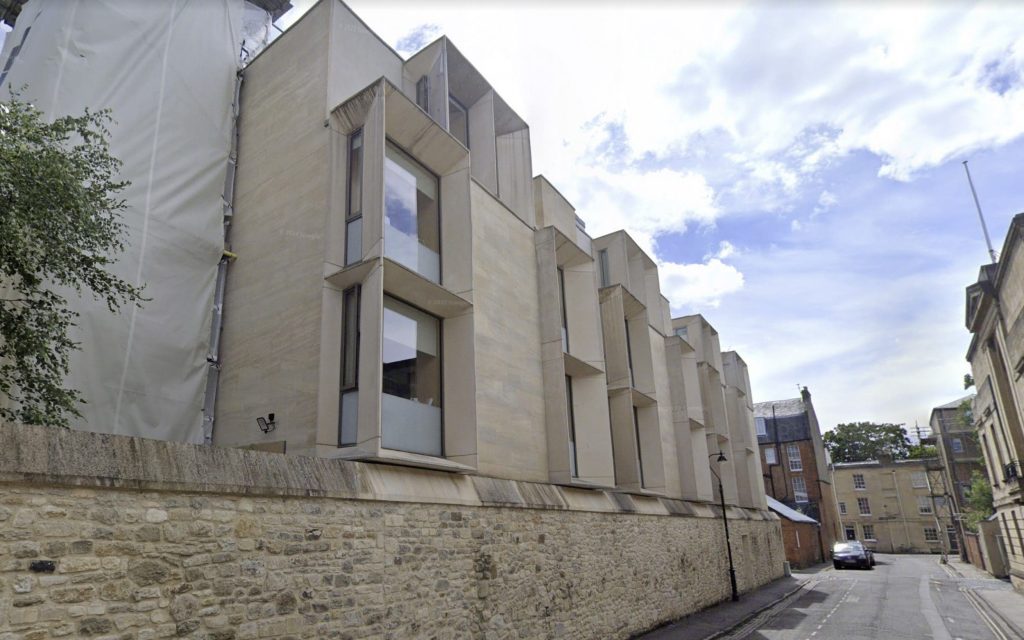
by Theodore Dalrymple
Absurdity is nothing new in human affairs, but it seems to be increasingly predominant in Western society since the vast expansion of tertiary education. Frequently one does not know whether to sit down because of the dangers posed by helpless laughter, or to climb up to the roof in order to throw oneself off. Horace Walpole said that life is a tragedy to him who feels and a comedy to him who thinks. To those who both feel and think—or perhaps I should say think and feel—it is a tragicomedy.
The story of the modern addition to Pusey House in Oxford is a case in point. Only three years after it was completed and opened, it has had to be closed because it is cracking up, but not with laughter. At the time of its opening, it was lauded by the usual suspects as being “innovative” in design, but we have enough experience of innovation by modern British architects to know that the word in their mouths means ugly, dysfunctional, and improvable only by demolition. W.B. Yeats was an architectural visionary when he said that things would fall apart and the center could not hold.
The new building was designed as an extension to Pusey House, and naturally the architects felt obliged to demonstrate their originality: God forbid that they should take any lessons from their benighted predecessors. It is both startling and in a way depressing to realize that the older building of Pusey House, which is beautiful, is not so very old: It was completed in 1918, and a graceful Gothic chapel was completed as late as 1939. Instances of radical incompetence, both technical and aesthetic, are comparatively late, and now accelerating, developments.
To its credit, Oxford City Council at first refused to grant permission for the extension to be built, on the self-evident grounds that the proposed building was not in keeping with what already existed and was an eyesore. The Victorian Society also objected. Oxford is, of course, one of the greatest assemblages of architectural beauty in the world, but practically every construction of the past seventy years has subtracted from that beauty, often gravely, and most of what has been built of late years has been not only bad but absolutely hideous, a kind of wound to the retina.
The council, alas, was overruled, including by people whose sole job it was to preserve the artistic heritage of the country. We live in a world of newspeak, however, in which preservation of the heritage means destruction of the heritage. When such people say that a building is “ingenious and successful” (as they did), you can be sure that it is inconvenient and good for nothing.
“Shortly after the building was fully completed,” said a statement issued by its owners, St. Cross College, “it was discovered that the glass reinforced concrete surrounds had begun to deteriorate…. It became clear that replacement was necessary.”
The architects disavowed all responsibility, of course. They merely designed the building and had nothing to do with the way in which it was built. They said that there was nothing wrong with their design—other than its ugliness, of course, which is merely in the eye of the beholder and therefore entirely subjective. As to the builders whose work was so shoddy, they had in the meantime gone bankrupt, so no one can now be held responsible. The need to replace the window surrounds at great cost so soon after completion will, of course, stimulate the economy à la Keynes, stoking demand for concrete and thereby helping to prevent recession in these difficult times. All, therefore, is for the best in this, the best of all possible worlds. No one is to blame for anything except, possibly, those protected by the bankruptcy laws.
There is, I need hardly say, a less sanguine interpretation of the debacle: that it reveals in its small way the state of the nation and even of our civilization itself, for it reveals what might be called the multilayered—or hydra-headed—incompetence, stupidity, and destructiveness that now pervade it.
First there was the incompetence of the designers of the thing; then there was the incompetence of those who had the deciding power and allowed the thing to be built; then there was the incompetence of those who actually built it and who, no doubt from greed, skimped on the materials; then there was the incompetence of those charged with ensuring that specifications were met and the thing was properly built. Finally there was the incompetence of the university itself, which allowed or required its spokesman to say, “It has taken time to find a permanent solution to the issues with the window surrounds; however, going forward, the university looks forward to being able to enjoy the West Wing building of St. Cross for many years to come.” No organization that employed such a person to represent its views to the public could be relied upon to make minimally competent decisions. The very word issue is weaselly and is used to cover or minimize a multitude of sins—past, present, and to come—and to imply impersonality to human actions and decisions. In my opinion, the word should never be used except in the context of publication, for example, “The post office’s issue of a stamp,” or as a verb to describe the leaving of a building.
Alas, the real question is not could I do better, but could I do worse?
First published in Taki’s magazine.








One Response
It needs pikes to put their heads on.